Want to Plan a Trip to Olympic National Park? Start Here!

Planning a trip to Olympic National Park? If you feel overwhelmed once you realize how far apart the top attractions are—and how much driving it takes to reach them—you’re not alone.
As a local guide, one of the first things I tell clients during trip planning sessions is this: don’t try to see the park from one home base. Staying in at least two locations along the Highway 101 loop can save you hours of backtracking.
This means more time seeing the park’s iconic mountains, rainforests, and beaches.
After more than a decade exploring the Olympic Peninsula, I’m sharing all my insider tips—when to visit, how many days to spend, the best way to get here from Seattle, what to pack for unpredictable weather, and realistic itineraries for your trip length.
Let’s go!
Not sure where to start?
I offer custom itinerary planning to help you skip the guesswork and save hours (or days!) of research.
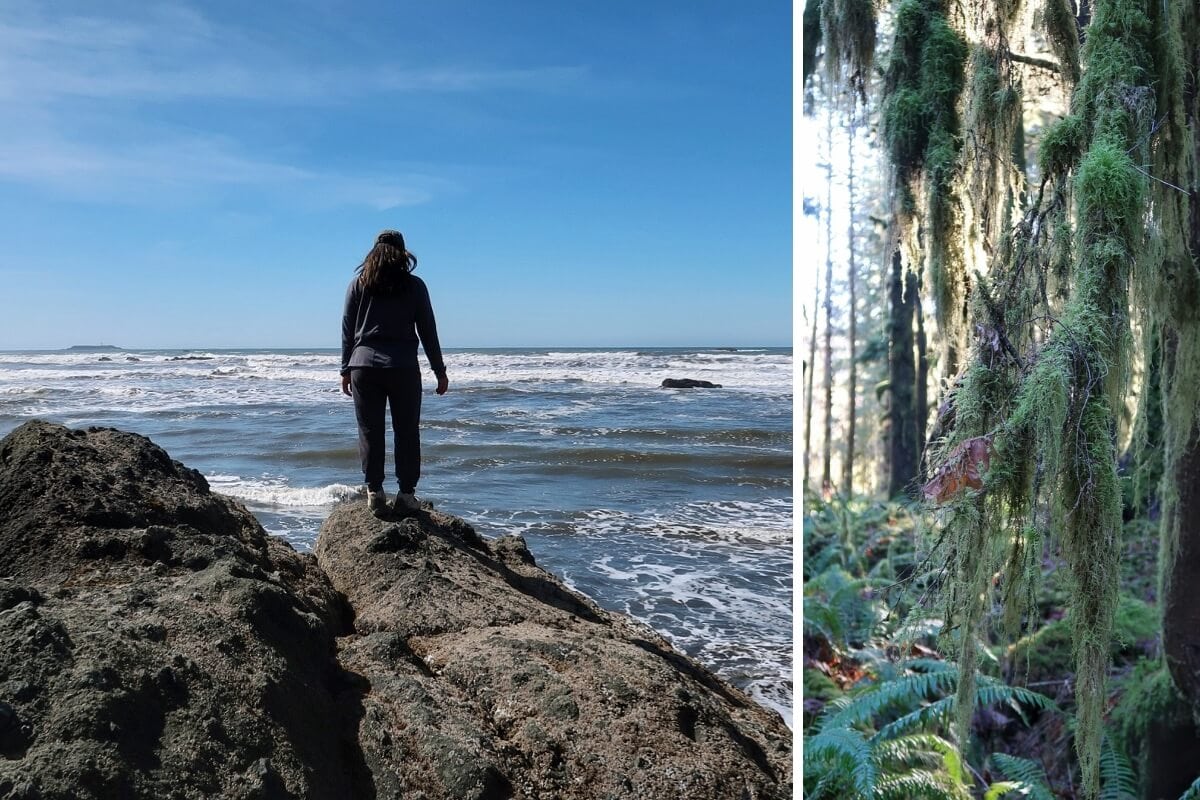
Quick Trip Planning Guide for Olympic National Park
- Closest major airport: Most visitors fly into Seattle-Tacoma International Airport (SEA), with US and international connections.
- Drive time from SEA to park: 2.5–4 hours, depending on which region you’re visiting. If you arrive late, stay at a SeaTac hotel before driving. I avoid Highway 101 at night because it’s winding and not well lit.
- Do I need a car? Yes. Olympic’s top attractions are hours apart, and public transportation is limited. Renting a car at SEA is the easiest way to get around.
- Do I need a ferry?: Only if you want to take one. I recommend the Bainbridge route—you’ll drive past Poulsbo’s Town & Country Market, an excellent spot to eat before continuing another 1.5 hours to Port Angeles.
- Best towns: Stay in Port Angeles or Forks, the most popular, but I’ll share why I love staying in Quinault below.
- Park pass required?: Yes—an Annual Pass, an America the Beautiful pass, or a $30/vehicle Standard Pass.
- How many days do I need?: Most first-time visitors spend 3–5 days. If you only have time for a day trip, I’ve got tips for that, too!
Now that you’ve got the basics, here’s what to see—and how to visit Olympic National Park smartly.
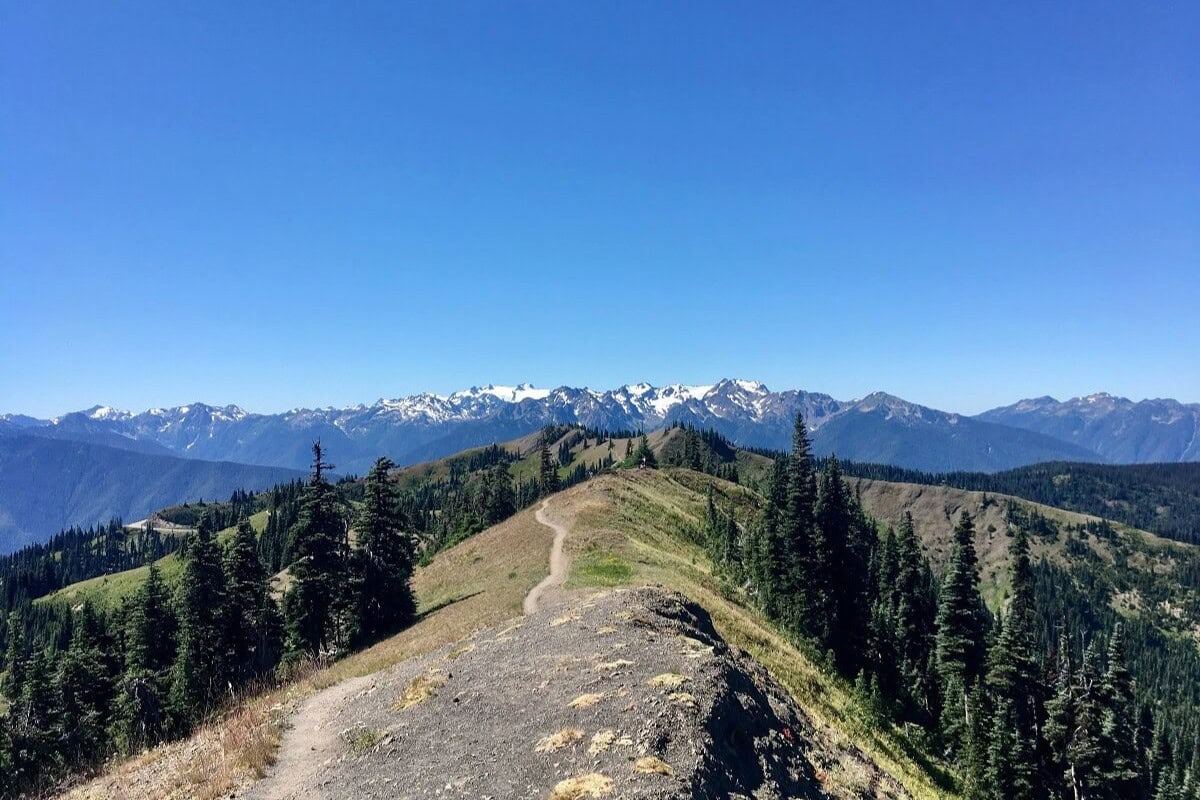
Best Olympic National Park Attractions for First-Timers
Olympic’s diversity means I can stand at 5,242 feet on Hurricane Ridge before lunch, walk mossy rainforest trails by the afternoon, and watch the sunset over the Pacific Ocean that same evening.
If you’re looking for the best things to do in Olympic National Park, start with these three attractions:
- Marvel at the Olympic Mountains – You’ll get sweeping views of jagged peaks when visiting Hurricane Ridge—even from the parking lot. Hike the paved Hurricane Hill Trail to see Mount Baker in the Cascades on clear days.
- Hike the Hoh Rain Forest – Grand, ancient trees draped in lichen line the iconic Hall of Mosses Trail. I love visiting when the forest floor is still saturated. By late summer it’s drier, but the moss covered trees are stunning year-round.
- Explore Olympic Coast Beaches – Sea stacks, tide pools, and dramatic views define Olympic’s rugged beaches. Second Beach is my favorite, but Point of Arches on Shi Shi Beach feels otherworldly.
Check tide charts to time your beach hikes for low tide. Always watch the tide as it comes in so you don’t get stuck!
Of course, knowing what to see is only part of the puzzle. How long should you give yourself to see it all?
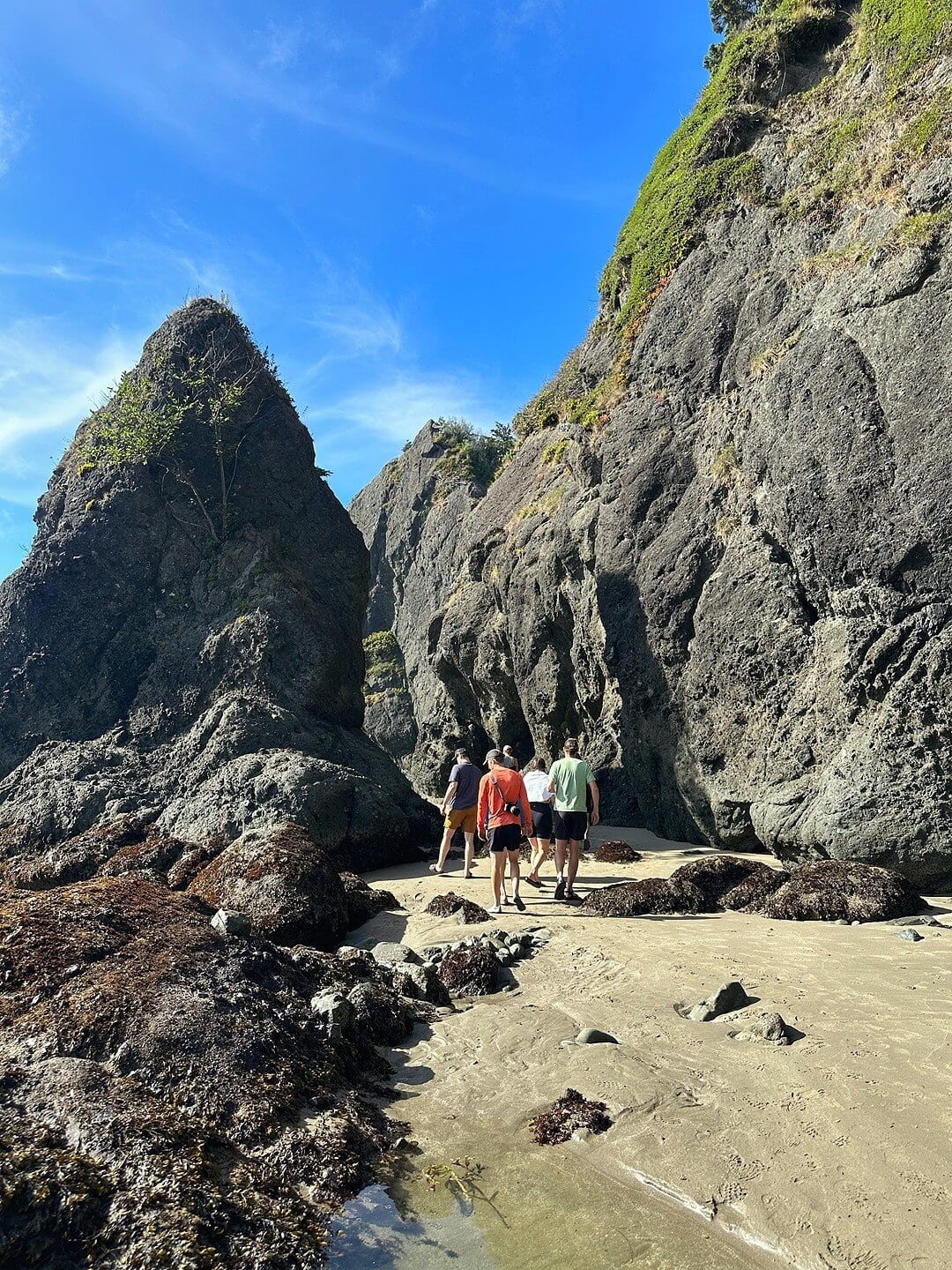
How Many Days Should You Spend in Olympic?
Driving the Highway 101 loop between regions takes time—so how long you stay really matters. Here’s what’s realistic based on your trip length:
- 1 day – Explore one or two regions in depth rather than hopping around. → Check out my 1-day Olympic National Park itinerary post.
- 2 days – See the park’s highlights on a two-day trip. → Here’s my 2-day Olympic National Park itinerary with an efficient route.
- 3–5 days – Explore all three ecosystems—mountains, rainforest, and coast—without rushing. Plan to stay in at least two different regions.
- 5–7 days – Ideal for a deeper experience with time for hiking, tide-pooling, and slower travel between bases.
My recommendation is 3–5 days so you can see Olympic at a more leisurely pace. If you only have 1–2 days, follow my itineraries to make the most of it.
Some disagree, but I wholeheartedly believe a day trip is worth it—especially if you take a guided day tour from Seattle.
Want help planning your trip?
Here’s what a recent client said:
“It was like getting trip advice from an old friend you can trust. The itinerary gave us a solid framework and peace of mind. I’d definitely recommend her.”
➜ Book a call here.
Towns & Cities Near Olympic National Park
Where you stay will affect your whole trip because of the driving involved with getting to park attractions.
For first-timers wondering how to plan a trip to Olympic National Park without wasting hours in the car, the key is choosing the right home base.
Below, I breakdown towns and regions to consider.
Port Angeles
It’s the peninsula’s largest city with the most dining and lodging—and even a seasonal shuttle to Hurricane Ridge. The greater Port Angeles area stretches east toward Sequim and west toward Lake Sutherland and Lake Crescent.
It’s the best base for visiting the park’s northern attractions, but not ideal for exploring Olympic beaches because of the long round trip drive.
Forks
I hear a lot of out-of-towners knock Forks for being a little sleepy. Sure, it doesn’t have a downtown like Port Angeles, but it’s hands-down the best base for exploring the coast and the Hoh Rain Forest without wasting time driving back and forth.
The Thriftway supermarket doubles as an outfitter—you can pick up groceries and rain gear in one stop.
Kalaloch / Quinault
This beach-and-rainforest combo is underrated, in my opinion. Both Kalaloch Lodge and Lake Quinault Lodge are destinations in themselves, with on-site restaurants, gift shops stocked with essentials, and world-class scenery right outside your door.
Lake Quinault Lodge is my favorite of all accommodations on the peninsula, though Kalaloch puts you closer to Forks-area attractions.
Sequim
I think of Sequim as the best “backup” to Port Angeles because it’s so close. While staying here means a little more driving to reach park attractions, you’re near restaurants and the excellent local farmers market, held Saturdays from May through October.
Sequim’s Dungeness Spit is outside the park, but it’s my go-to beach walk an hour from home and a must-see for birders.
Olympic National Park Entrances & Regions
Because the park is spread across the Olympic Peninsula, there’s no single entrance gate.
Instead, you’ll find ranger-staffed entrance stations at key access points, including the roads to:
- Hurricane Ridge
- Sol Duc Valley
- the Hoh Rain Forest
There are no official entrance stations at Lake Crescent, Pacific beaches, or Quinault Rainforest trailheads, but you’ll find ranger stations in these areas.
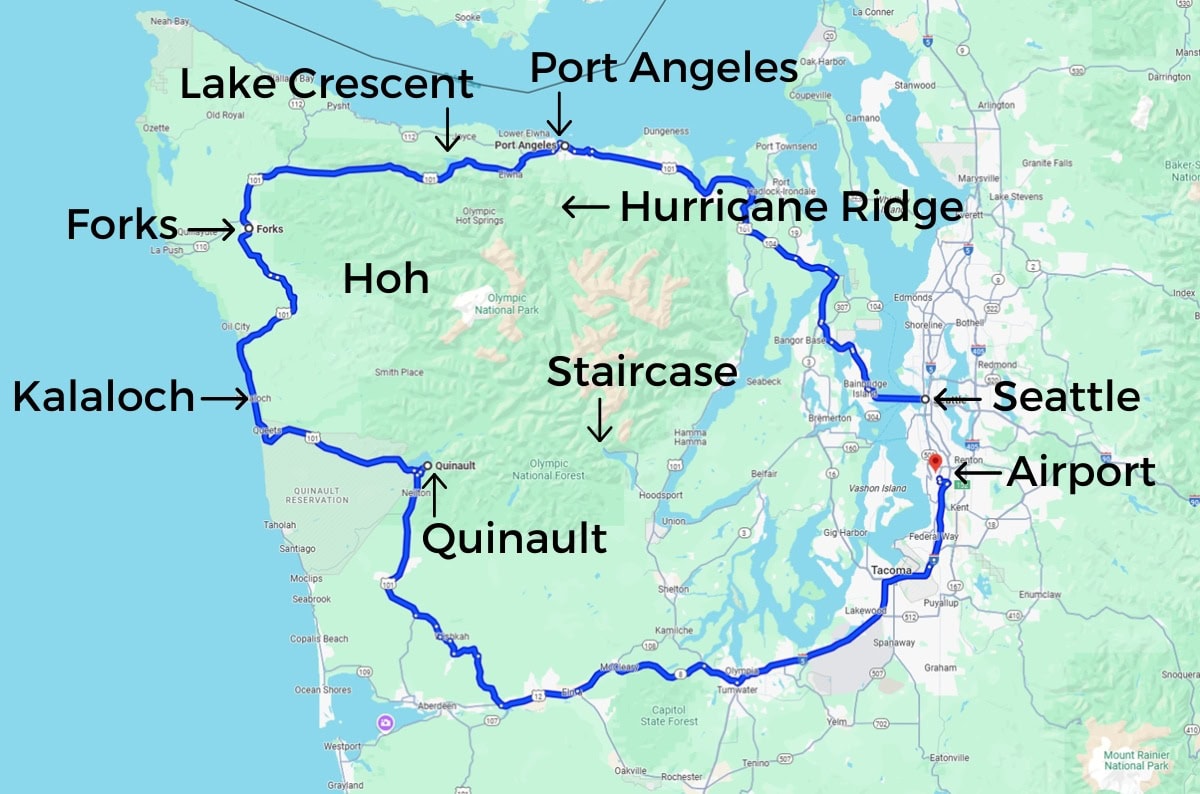
On a January visit to Hurricane Ridge, I forgot our snowshoes. A quick chat with a ranger reassured us they weren’t needed that day, which saved us a lot of stress.
If you’d like to talk with a ranger, fill up your water bottles, or pick up a map, stop at the visitor center in Port Angeles. It’s family-friendly and an easy stop before or after heading up to Hurricane Ridge.
Here’s a quick overview of the park’s regions:
- North: The most visited part of the park, featuring Hurricane Ridge, Lake Crescent, the Elwha River, and the Sol Duc Valley. I often advise clients on how to best fit in the scenic coastal drive along Highway 112 to Neah Bay and Cape Flattery.
- West: This region is home to Olympic’s wild beaches and access to the Hoh Rainforest. The drive from Ruby Beach to Kalaloch features incredible ocean views, with plenty of pullouts to stop and soak it in.
- South: This area includes Kalaloch, the Quinault Rainforest, and the many creeks along stunning Olympic National Forest trails. It’s also where backpackers head into the Enchanted Valley—known as the “Valley of 10,000 Waterfalls.”
- East: The Staircase region near Hoodsport is less visited than other parts of the park, but it’s the closest to Seattle. Kids love climbing the boulders alongside the Staircase Rapids Loop Trail and recreation around Lake Cushman.
How to Get to Olympic National Park from Seattle
Most visitors start their park tour in Port Angeles, then follow the loop west toward Forks and south along the coast.
Coming from Seattle proper (about 20–25 minutes north of Sea-Tac Airport, depending on traffic), I prefer taking a ferry over driving around.
It’s more scenic, gives you a break from driving and the chance to see Mount Rainier on a clear day.

Ferry Options
- Seattle to Bainbridge Island (30 min) My personal favorite for its frequent departures and dining options on Bainbridge’s Winslow Way, close to the terminal.
- Seattle to Bremerton (60 min) It’s a longer boat ride and a longer drive to the Hood Canal Bridge, so I rarely choose it.
- Edmonds to Kingston (30 min) Requires a 30-minute drive north of Seattle. Best if you’re coming from the North Cascades.
Some locals love the Kingston ferry, probably because the Edmonds terminal has a nice beach and plenty of nearby restaurants.
To me, the extra driving from SeaTac Airport or downtown Seattle isn’t worth it, and the weekend wait times are frequently long.
Driving Around (No Ferry)
You can skip the ferry and take I-5 south through Tacoma to Highway 16.
You’ll cross the Tacoma Narrows Bridge through Gig Harbor, then connect to Highway 3 through Bremerton to the Hood Canal Floating Bridge to reach the Olympic Peninsula.
Before you go, check the status of the Hood Canal Bridge. You’ll cross it whether you take a ferry or drive around.
When to Visit Olympic (Weather & Seasonal Tips)
The only thing predictable about Olympic National Park’s weather is its unpredictability.
Depending on the season, I dress so I’m ready for rain, sun, heat, and cool temperatures, often on the same day.
Spring (March – Early June)
Spring is a shoulder season with fewer crowds. I love this time of year because I can experience parts of the park in near solitude.
The weather swings wildly. One Friday in May, my husband and I walked First Beach bundled in winter coats and beanies. By Sunday, we were in shorts and T-shirts on Second Beach.
Snow often lingers into June at higher elevations. If you plan to hike at Hurricane Ridge, bring layers and check conditions.
Summer (Late June – August)
Summer is the most popular time to visit Olympic. Book your lodging early and get to trailheads by 8:30am—parking fills fast, especially on weekends.
Early June weather is often still moody. Locals call it “Junuary” when the clouds and rain stick around. The tradeoff is lots of daylight to spend on summer hiking trails.
By July, enjoy warm afternoons with little to no rain. But even in summer, expect cooler temperatures near the coast and rainforest.
On one July trip to the rainforest to hike the Hoh River Trail, we needed mid-layers every morning and evening.

Fall (September – November)
Fall is one of my favorite seasons for hiking. Eighty-degree days aren’t uncommon through the first week of October.
After the first week of October, the rain usually returns—but that also means mushrooms start popping up and salmon return to spawn in area rivers. The Elwha River is one of the best places to see fall colors.
Rain gear is a must, especially for mid- to late fall hikes.
Winter (December – February)
Winter in Olympic is wet, but January and February often bring surprisingly sunny days. Just be ready for rainstorms anywhere in the park.
Expect snow at higher elevations. Layers are important year-round, but especially in winter.
On one hike to Hurricane Hill, my friend Jenna started bundled in a puffy coat and shed layers to a tank top halfway up the trail.
Always check for road closures before you head out.
Know Before You Go
- Check weather.gov for the most reliable forecast before your trip, especially before heading up Hurricane Ridge Road.
- Be mindful of seasonal road and trail closures due to flooding, snow, or washouts (especially in late fall, winter, and spring). In spring 2024, many first-time travelers were caught off guard when the road to the Hoh was closed—and had to scramble to adjust their plans mid-trip.
- On the coast, sneaker waves and winter storms are a dangerous combination. Every year, visitors are caught off guard—and some have lost their lives. Pay attention to weather advisories and never turn your back to the ocean.
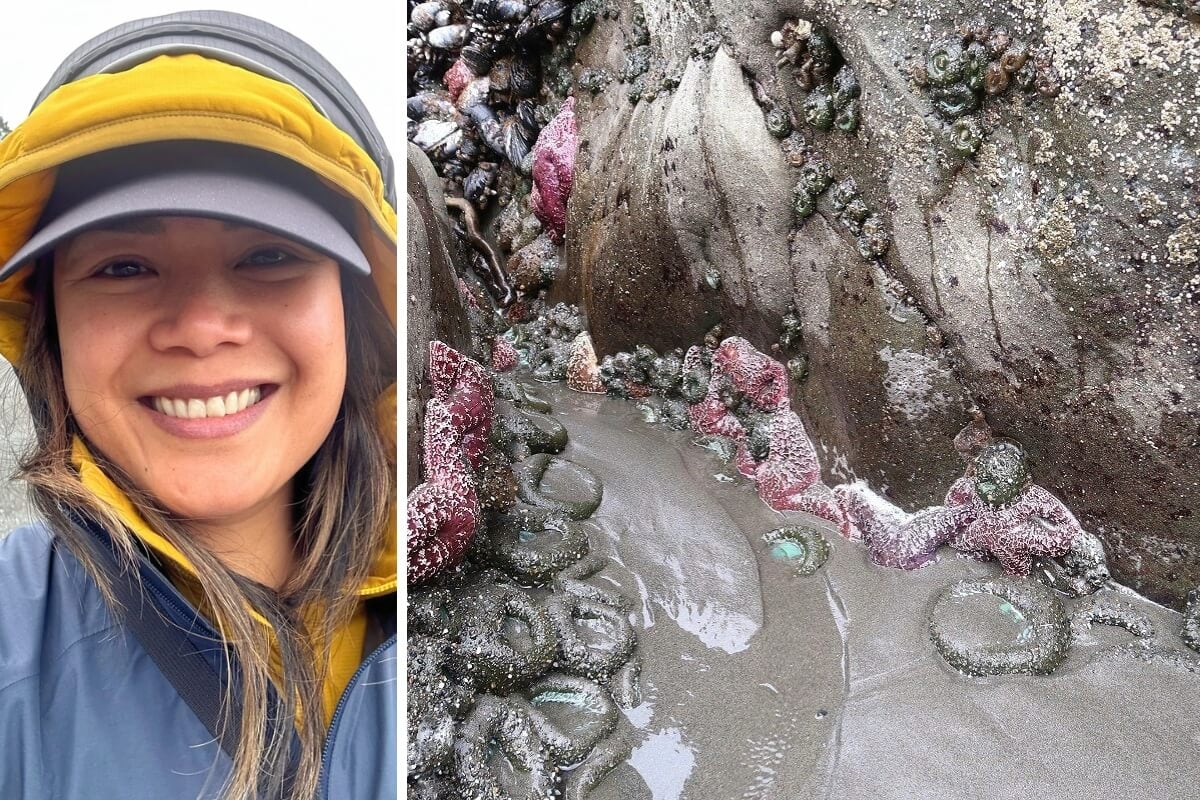
What to Pack for Olympic’s Weather
If you’re wondering what to pack for Olympic National Park, my best advice is to be ready for changing conditions.
Even in summer, bring smart layers that keep you dry, comfortable, and never overheated.
Below are my go-to essentials.
Year-Round Essentials
- Daypack – Big enough to fit extra layers, snacks, and a hydration bladder. I always choose one with a hip belt to save my shoulders from the weight of my gear.
- Waterproof boots or hiking shoes – Necessary for muddy trails and wet beach walks. My feet have always stayed dry, even when it rains or I step in a puddle.
- Softshell jacket – The workhorse of all my outdoor apparel. Lightweight, wind-blocking, and water-resistant—this is a must-bring layer on nearly every hike.
- Layered clothing – A breathable base layer, insulating mid-layer, and rain jacket allow you to add or remove clothing as needed.
This essential layer zips on quickly when the wind picks up or the weather turns—so you can keep hiking.
What to Book Ahead of Time (Trip Timeline)
- 6–12 months: Lodging and reservations for the Kalaloch and Hoh Rain Forest campground, especially for summer trips
- 3–6 months: Whale-watching tours and guided hikes
- 2 months: Ferry reservations (only needed if you’re getting to the peninsula via the Coupeville Ferry to Port Townsend)
- Day of: If you want to soak at Sol Duc Hot Springs, reservations are first come, first served and must be made in person.
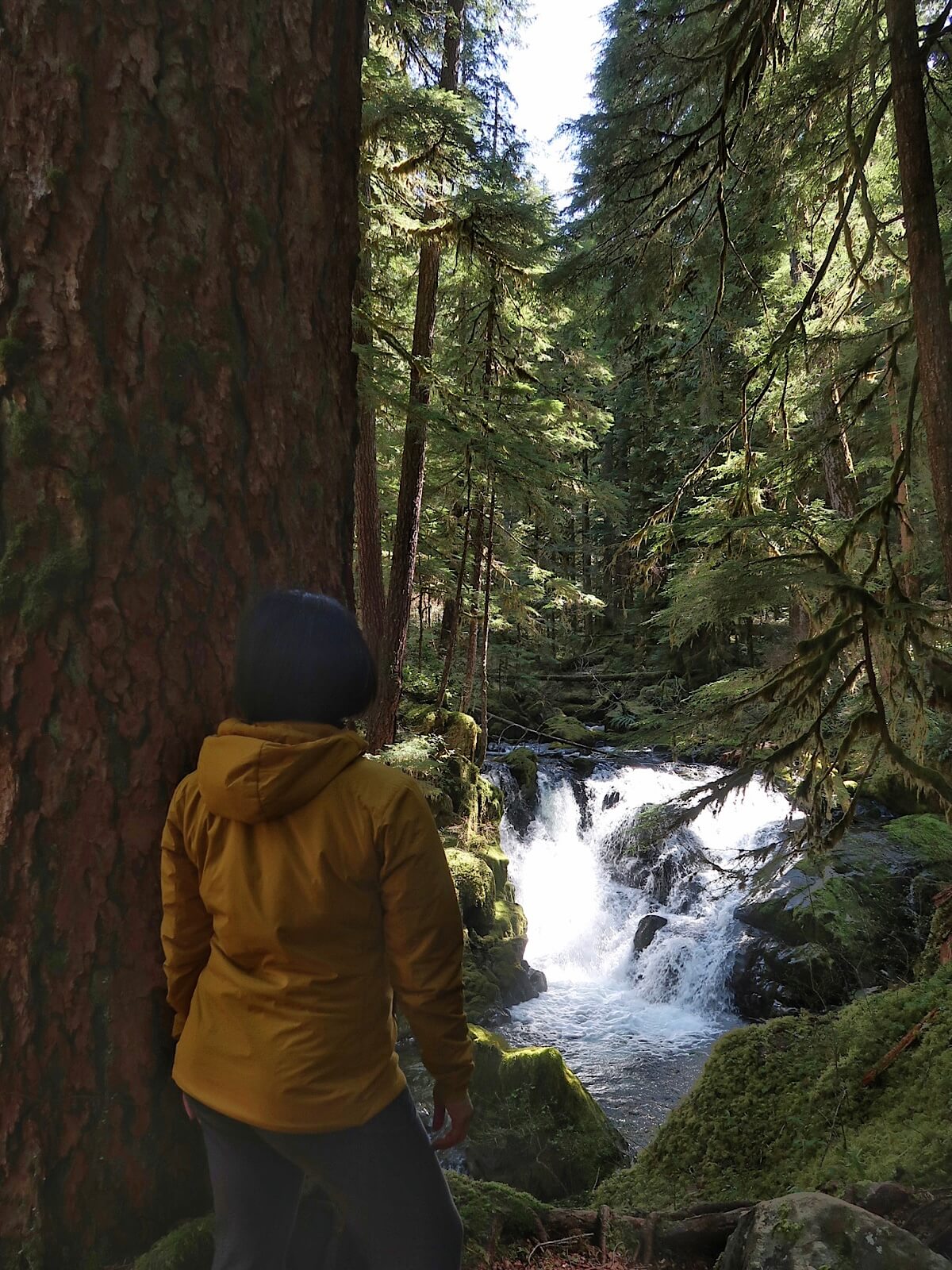
FAQs: Visiting Olympic National Park
★ How long does it take to drive the Highway 101 loop?
Driving the complete Olympic Loop with minimal stops takes about 7 to 9 hours, depending on traffic and road conditions. It’s nearly 330 miles and covers forests, mountains, valleys, and the Pacific coast.
Most visitors spread it out over 3 to 4 days, stopping at popular spots like Hurricane Ridge, Lake Crescent, Sol Duc Falls, Rialto Beach, and the Hoh Rainforest.
★ What month is best for Olympic National Park?
If you’re visiting from out of town, July is your best bet for clear weather and minimal rain. Just know that our lack of rain in summer can make Hoh Rain Forest trails look less lush.
That said, mid-September to early October is the sweet spot. You might get some rain, but the tradeoff is fewer crowds, easier parking, and a chance to see fall color, mushrooms along the trails, and salmon returning to spawn.
★ Are dogs allowed in Olympic National Park?
Dogs are allowed in a few specific park areas but not on most trails. If you’re bringing a pet, follow the BARK rules:
- Bag your pet’s poop
- Always wear a leash
- Respect wildlife
- Know where you can go
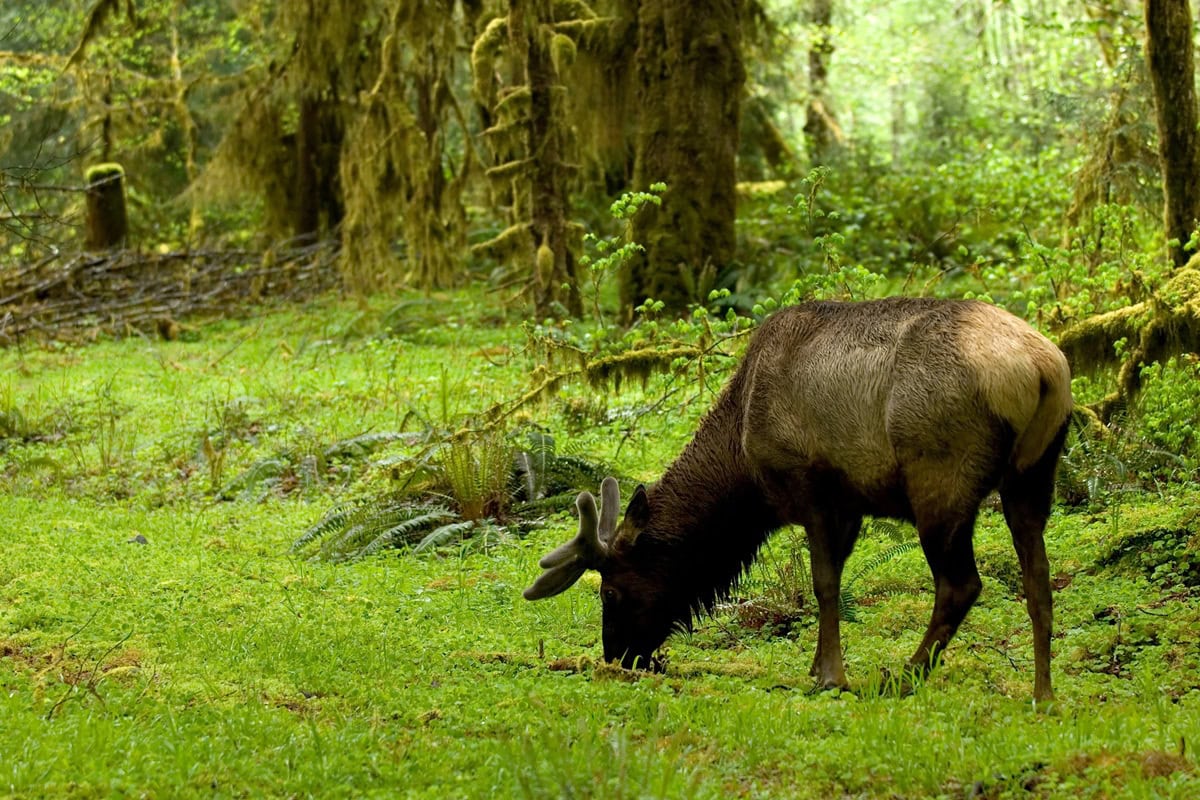
Ready to Plan a Trip to Olympic National Park?
Olympic is one of the most diverse national parks in the United States.
I once worked with a couple on a babymoon who wanted to see it all—and avoid the crowds over the 4th of July weekend. With the right pacing and a few smart route tweaks, they got a relaxed, scenic trip without the stress.
👉🏽 Need help creating a stress-free itinerary?
Book a consultation and let’s map out a custom route that fits your pace and priorities.
👉🏽 Prefer to DIY your trip?
Read my Olympic National Park lodging guide for region-by-region recommendations, including the places I’ve personally stayed.
RELATED TRIP PLANNING POSTS:
➥ Plan Your Perfect Trip to Olympic National Park (Start Here!)
➥ 7 BEST Towns Near Olympic National Park Worth Visiting!
➥ 21 Places To Stay Near Olympic National Park (By a Local!)
➥ 10 BEST Summer Day Hikes on the Olympic Peninsula
➥ 13 BEST Beaches on the Olympic Peninsula
➥ 2 Day Olympic National Park Itinerary (Easy & Efficient!)
➥ Olympic National Park Day Trip (Best 1-Day Itineraries!)
➥ What to Pack for Olympic National Park (All Year!)
➥ Best Shoes for Olympic National Park Trails, Towns & Beaches
➥ Olympic National Park Visitor Center: 7 Reasons to Stop
SEASONAL TRAVEL POSTS:
➥ Fall in Olympic National Park (11 Best Things to Do!)
➥ Winter in Olympic National Park: 7 Things to Do + What’s Open
Skip the guesswork, stress, and hours of research—let me help you plan your itinerary!


